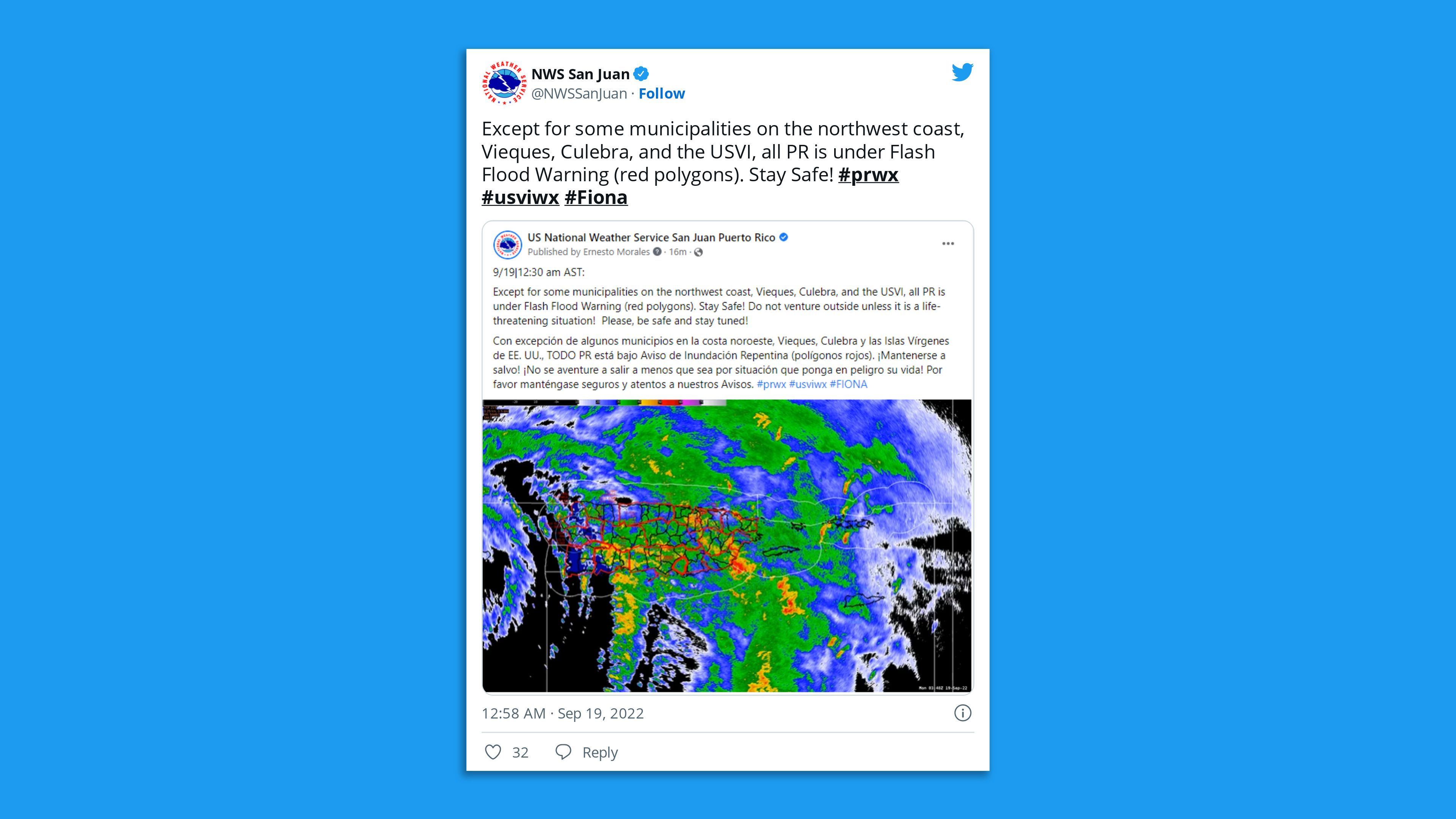An intensifying Hurricane Fiona is bringing heavy rains and high winds to Puerto Rico, knocking out power to the entire island.
The latest: The eye of Fiona was approaching the coast of the Dominican Republic, near the town of Punta Cana, as heavy rainfall and "catastrophic flooding" continued across much of Puerto Rico, the National Hurricane Center tweeted early Monday.

- Hurricane warnings were in effect for Puerto Rico, the coast of the Dominican Republic from Cabo Caucedo to Cabo, and the Turks and Caicos Islands, according to a National Hurricane Center advisory issued at 2am Monday that estimated Fiona's maximum sustained winds at 85 mph.
- There were no immediate reports of fatalities in Puerto Rico, though officials in the U.S. territory said it's too soon to assess damage with heavy rains forecast to continue lashing the Caribbean island through Monday.
The big picture: Fiona made landfall near Punta Tocon, on Puerto Rico's southwestern coast, around 3:20pm local time with maximum sustained winds of 85 mph, per a National Hurricane Center tweet.
- The Category 1 storm was dumping more than 2 feet of rain in Puerto Rico, "causing catastrophic" flooding, the NHC said Sunday. Hurricane-force winds took out the island's fragile power grid.
- Ponce, on the southern side of the island, has seen sustained winds of 69 mph with a maximum wind gust of 103 mph, per the Hurricane Center.
- President Biden has declared a federal disaster for Puerto Rico, mobilizing the delivery of aid to the island.
Threat level: The storm was likely to bring torrential rains and hurricane-force winds to both the Dominican Republic and Puerto Rico through Monday, with a widespread area of 12 to 18 inches of rain expected in some places.
- Higher amounts will fall in some locations of Puerto Rico, particularly in higher elevations, where up to 30 inches could fall in a short period of time.
- "These rains will continue to produce life-threatening and catastrophic flash and urban flooding across Puerto Rico and the eastern Dominican Republic, along with mudslides and landslides in areas of higher terrain," the Hurricane Center warned as of 2am Monday.
Meanwhile, Puerto Rico's power grid, which was severely damaged during Hurricane Maria in 2017, has faltered, with nearly 1.5 million customers without power as of 3am ET, according to Poweroutage.us.
- The test for utility operators is how quickly they can restore power once the storm passes.
As Puerto Rico‘s governor was briefing the island ahead of Fiona‘s impact the lights went out. The governor has already said LUMA Energy - the private company in charge of transmission & distribution of electricity on the island - is on probation with him. pic.twitter.com/YVEnPPcnZp
— David Begnaud (@DavidBegnaud) September 17, 2022
What they're saying: "The damages that we are seeing are catastrophic," Puerto Rico Gov. Pedro Pierluisi said.
Of note: NOAA scientists managed to sail a remotely operated "Sail Drone" into the eye of Hurricane Fiona, which helped validate their intensity estimate.
- Storm surge flooding of 3 to 5 feet above normally dry land was expected along Dominican Republic coastal areas and later in the coastal regions of the Turks and Caicos could see water levels raised by 2 to 4 feet.
- The NWS in San Juan was issuing flash flood warnings from Sunday through Monday as the rains cause rivers and streams to rise. Video from social media shows torrents of water washing away bridges, power lines and other infrastructure in southwestern Puerto Rico.
- The storm previously caused damaging flooding after dumping nearly 20 inches of rain on the French island of Guadeloupe late last week.
What's next: It's expected that Fiona will become the season's first "major" Atlantic hurricane of the season, at Category 3 intensity or greater by midweek.
- Most computer models now take the storm out to sea well east of the mainland U.S., but it could be a threat to Bermuda late in the week.
Editor's note: This article has been corrected to note that Punta Tocon is on Puerto Rico's southwestern coast, not southeastern. The caption was updated to correct the date to Sept. 18, 2022, not 2002."







